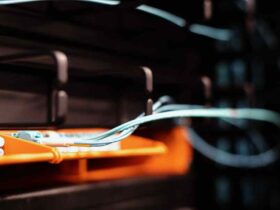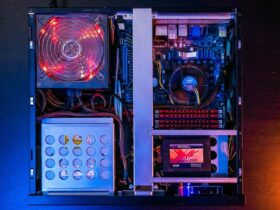In the intricate world of computer technology, the motherboard stands as the central hub, orchestrating the symphony of digital processes. Integral to a computer’s architecture, it demands careful installation to ensure optimal performance and longevity. Key to this installation is the use of spacers—small yet crucial components that elevate the motherboard above the computer case. This article delves into the significance of these spacers, shedding light on their critical role in safeguarding the motherboard from potential hazards. We will explore the myriad benefits they offer, from preventing electrical short circuits to enhancing system cooling, thereby illuminating their indispensability in computer assembly.
Why Might A Motherboard Be Installed On Top Of Spacers?
Installing a motherboard on top of spacers is a crucial practice in computer assembly for several important reasons:
- Preventing Short Circuits: The primary reason for using spacers, often called standoffs, is to prevent short circuits. A motherboard contains numerous metal traces and solder points on its underside. If these points come into direct contact with the conductive metal case, it can create a short circuit, potentially damaging the motherboard and other components. Spacers elevate the motherboard, ensuring that these sensitive areas do not touch the case.
- Enhancing Airflow And Cooling: By elevating the motherboard, spacers help in creating space for air to circulate beneath it. Good airflow is essential for cooling, as it helps to dissipate heat away from the motherboard and other components. This is particularly important for high-performance systems where overheating can be a concern.
- Facilitating Cable Management: Spacers can also aid in cable management. By raising the motherboard, more room is available for routing cables underneath or around it. This not only helps in keeping the interior of the computer tidy but also improves airflow by reducing cable clutter.
- Vibration Dampening: In some cases, spacers can also help in dampening vibrations from the computer case. Vibrations can be harmful over time to the electronic components on the motherboard. By providing a cushioned mounting, spacers can reduce the transmission of these vibrations.
- Ease Of Installation And Maintenance: Having the motherboard elevated makes it easier to install and access various components and connectors. This is especially helpful during initial assembly or when upgrading or maintaining the system.
- Protecting The Case And Motherboard: Spacers prevent the scratching or damaging of the case and the motherboard, which could happen if the motherboard were screwed directly onto the case. This is particularly important for preserving the integrity of both components over time.
The Role Of Spacers In Motherboard Installation
Spacers, commonly known as standoffs, play a critical role in the installation of motherboards within computer cases. These small but crucial components are typically made from brass or plastic and are designed to securely position the motherboard within the case while maintaining a safe distance from the conductive metal chassis. The primary purpose of spacers is to prevent direct contact between the motherboard and the case, which could lead to electrical shorts and hardware damage. By elevating the motherboard, spacers ensure a safer and more stable environment for the delicate electronic components on the board.
The most significant function of spacers is to prevent electrical short circuits. The underside of a motherboard is lined with numerous solder points and conductive tracks. If these were to come into direct contact with the metallic surface of the computer case, it could create a short circuit, potentially leading to severe damage to the motherboard and other connected components. Spacers keep the motherboard elevated, ensuring that these sensitive areas remain isolated from the conductive parts of the case. This protective measure is essential for the longevity and functionality of the computer system.
Beyond preventing electrical shorts, spacers also contribute to better airflow and cooling within the computer case. By creating a gap between the motherboard and the case, spacers allow air to circulate beneath the board. This improved ventilation is crucial for dissipating heat generated by the motherboard and other components like the CPU, GPU, and memory modules. Effective cooling is particularly important in high-performance and gaming computers, where overheating can lead to reduced performance or hardware failure. Thus, spacers indirectly aid in maintaining optimal operating temperatures, ensuring stable and efficient system performance.
Apart from preventing short circuits and enhancing cooling, spacers also facilitate easier installation and maintenance. The elevated position of the motherboard allows for more accessible routing of cables and connections, contributing to better cable management and a tidier system interior. Additionally, spacers can help dampen vibrations from the case, protecting sensitive components on the motherboard. While the use of spacers is a standard practice in computer assembly, it’s important to use the correct type and size of spacers for specific motherboard and case combinations. Incorrectly sized spacers can lead to misalignment of component ports or insufficient protection, highlighting the
Tips For Ensuring Secure And Effective Placement.
When installing a motherboard using spacers, ensuring secure and effective placement is crucial for both the performance and longevity of your computer. Here are some essential tips:
- Choose The Right Spacers: Ensure the spacers are compatible with your motherboard and case. Typically, brass or plastic standoffs are used, and they should match the size and threading of the case’s mounting points.
- Correct Placement Of Spacers: Align the spacers with the screw holes on the motherboard. Only place spacers where there are mounting holes on the motherboard to avoid creating pressure points or damaging the board.
- Avoid Over-Tightening Screws: When securing the motherboard to the spacers, tighten the screws snugly but do not over-tighten. Over-tightening can damage the motherboard or the spacers.
- Check For Clearance: Before final installation, ensure there’s enough clearance between the motherboard and any underlying components or the case itself. This prevents shorts and allows for better airflow.
- Inspect For Metal Contact: Make sure no part of the motherboard is directly touching the metal case, as this can cause short circuits.
- Use Insulating Washers (if Necessary): In some cases, using insulating washers can prevent shorts, especially if the case is made of conductive material.
- Double-Check Alignment With Rear I/O Panel: Ensure the ports on the motherboard align correctly with the cut-outs in the case’s rear I/O panel. Misalignment can lead to difficulty in connecting external devices.
- Route Cables Efficiently: Plan your cable routing before securing the motherboard. This ensures cables don’t get trapped under the motherboard and are not stretched too tightly, which could dislodge connectors.
- Test Before Full Installation: It’s often a good idea to partially assemble and test the key components outside the case before full installation. This way, you can ensure everything is working correctly before finalizing the placement.
- Regular Maintenance: Periodically check the tightness of the screws and the integrity of the spacers. Vibration from fans and other components can sometimes loosen them over time.
Summary
In summary, installing a motherboard on spacers is a critical step in building a reliable and efficient computer system. Spacers prevent physical damage and electrical short circuits, aid in heat dissipation, and facilitate cable management. By choosing the right spacers, ensuring proper alignment, avoiding over-tightening, and conducting pre-installation tests, one can significantly enhance the motherboard’s performance and longevity. Regular maintenance and careful installation practices are key to ensuring that the motherboard remains securely and effectively in place, forming the backbone of a well-functioning computer.
FAQ’s
What Are Motherboard Spacers And Why Are They Used?
Motherboard spacers, also known as standoffs, are small supports that elevate the motherboard above the computer case to prevent electrical shorts and allow airflow.
Can I Install A Motherboard Without Spacers?
It’s not recommended, as installing without spacers can lead to electrical shorts, overheating, and physical damage to the motherboard.
Are All Motherboard Spacers The Same Size?
No, spacers come in different sizes and threads. It’s important to use the ones that fit your case and motherboard.
Do Spacers Help With Cooling The Motherboard?
Yes, by elevating the motherboard, spacers allow for better airflow, which helps in cooling the system.
How Many Spacers Do I Need For My Motherboard?
The number depends on your motherboard’s size and layout. Usually, a spacer is needed for each mounting hole on the motherboard.
























Leave a Reply